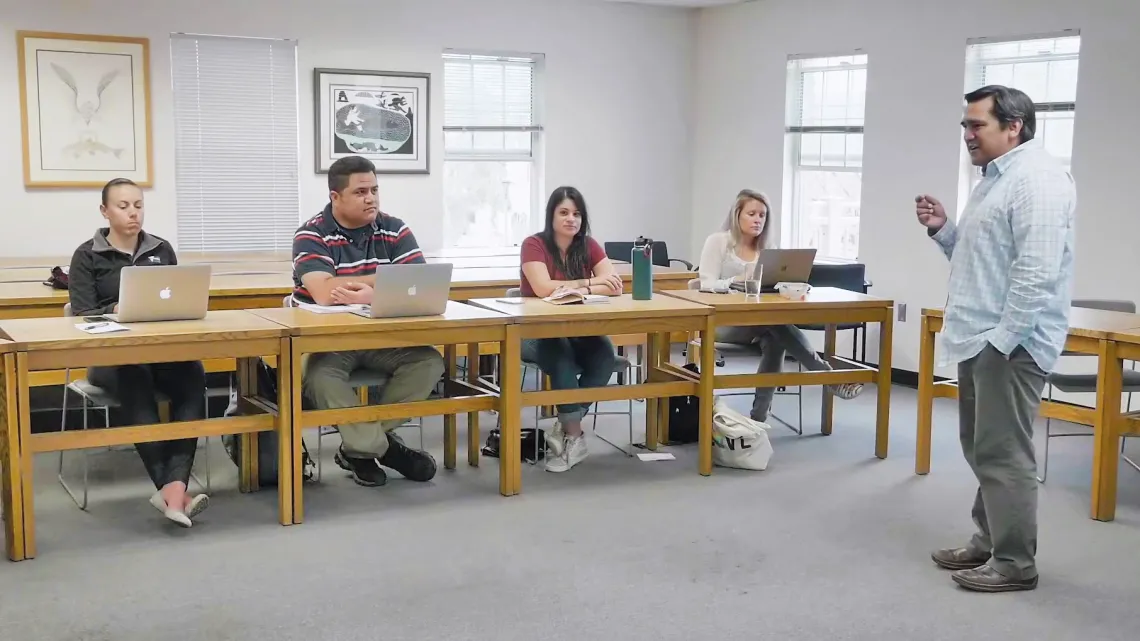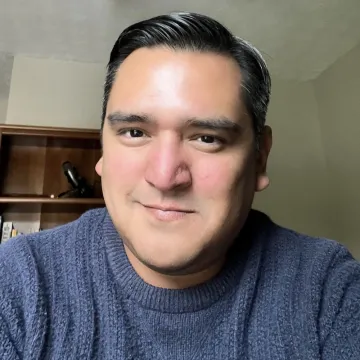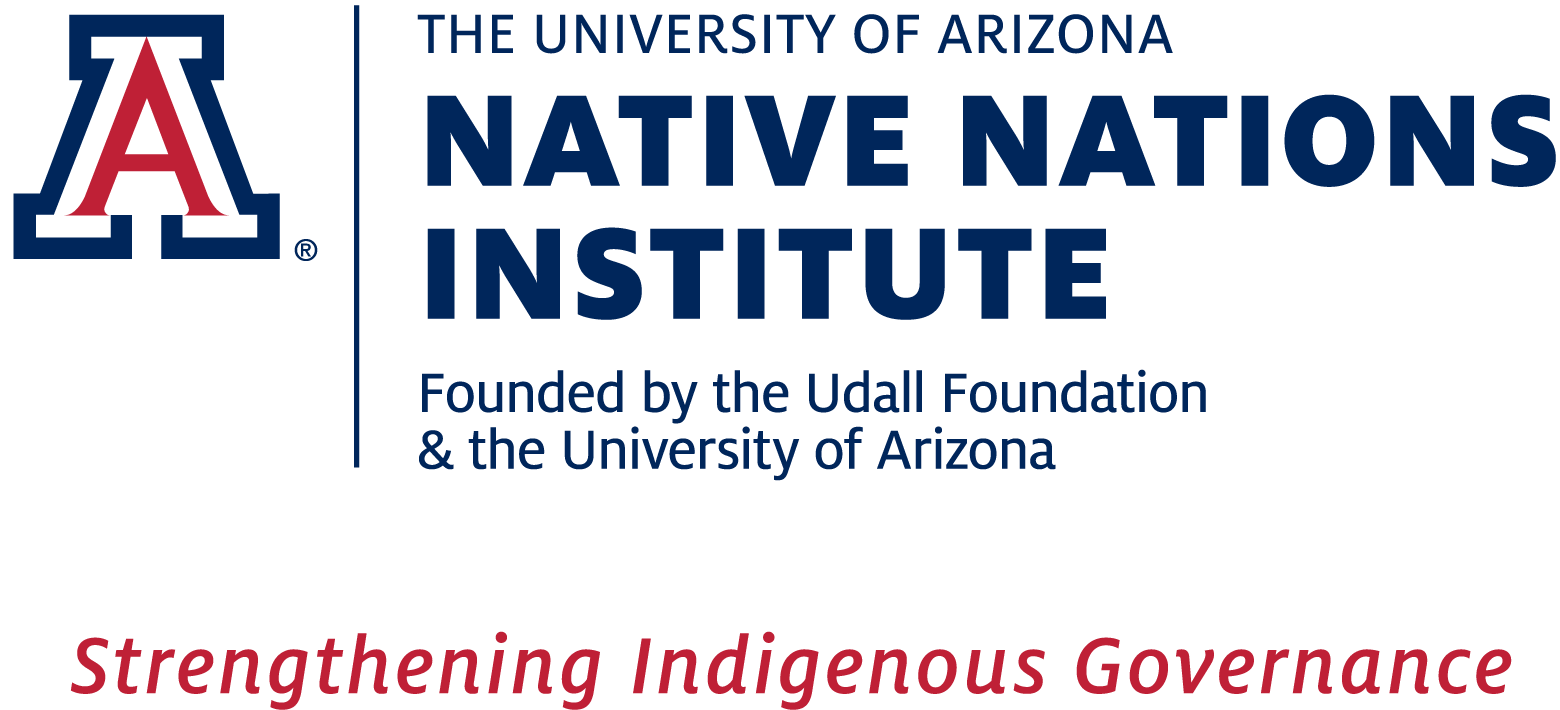How UArizona 'literally wrote the book' on Native nation building
Torivio Fodder, manager of the UArizona Indigenous Governance Program, explains the principles that drive successful tribal governance and why the university is a leader in the teaching of nation building.

Tory Fodder, manager of the UArizona Indigenous Governance Program, teaches a course during the 2020 January in Tucson event. The intensive education session, held each year, brings together distinguished faculty in the field of Indigenous governance and Indigenous rights, to teach and hold discussions with Indigenous leaders, practitioners and community members.
Courtesy of the Indigenous Governance Program
Torivio "Tory" Fodder has been a student of tribal sovereignty his entire life. Growing up in southern Oklahoma, Fodder's grandfather was a land surveyor for the Bureau of Indian Affairs and his father was a career real estate appraiser for the bureau.
Fodder, who is an enrolled member of Taos Pueblo in northern New Mexico, came to UArizona to study law under Regents Professor of law Robert A. Williams Jr., a renowned federal Indian law scholar and member of the Lumbee Tribe of North Carolina.

After graduating in 2010, Fodder went on to earn his S.J.D. – the equivalent of a Ph.D. in law – before going to work as a researcher for the Māori and Indigenous Governance Centre at the University of Waikaito in New Zealand. He later was associate director of the High Plains American Indian Research Institute at the University of Wyoming.
Today, Fodder is the manager of the UArizona Indigenous Governance Program, or IGP, which operates as a partnership between the university's Native Nations Institute, or NNI, at the Udall Center for Studies in Public Policy and the Indigenous Peoples Law and Policy Program at the James E. Rogers College of Law.
In addition to planning for the upcoming accelerated Indigenous governance education event, called January in Tucson, Fodder recently traveled to Albuquerque, New Mexico, to train high-level Bureau of Indian Affairs leadership on Native nation building principles.
Those principles, compiled and explored in detail in the 2007 book "Rebuilding Native Nations: Strategies for Governance and Development," are the cornerstone of the Indigenous Governance Program's teachings. NNI senior researcher Miriam Jorgensen edited the book, which includes contributions by other influential Indigenous Governance Program faculty, including NNI co-founder Stephen Cornell and executive director Joan Timeche.
In this Q&A, Fodder explains what Native nation building is, who should learn it and how UArizona experts helped define the practice in order to teach it to tribal leaders and, more recently, to senior-level federal officials.
Q: What made you decide to teach law rather than practice after graduating from UArizona?
A: I had kind of a latent understanding of Indian land issues really early on and that sparked my interest in Indian law. When I came to law school at UArizona, I attended some of the earlier Native nation building courses that we offered before they became the IGP. I remember learning about these nation-building concepts as a student and I thought, "That makes a world of sense. If our tribes could adopt or learn some of these principles and concepts, we could be in a much stronger position from a sovereignty standpoint."
Q: What is Native nation building?
A: In essence, Native nation building boils down to the principles for how a tribe or Native nation can govern themselves efficiently and effectively. Here at NNI, we've distilled it down to five key concepts.
The first one is the notion of practical self-rule. It's the idea that Native people and their communities ought to be in the driver's seat for determining their own futures. The second foundational point is strategic orientation. This is a challenge for every government, but it's the idea that a government ought to be thinking about the long-term impacts of their decisions. The third piece is capable government. That really amounts to making sure that a tribal government's institutions run efficiently, run effectively, are accountable to the people and that there's no "hiding the ball" in terms of how they operate and how the people can engage. The fourth piece of the puzzle is that there has to be a consistent cultural match. We're not talking about matching whatever governmental institutions we have now to how things were 200 years ago. The institutions have to match the culture of the Native nation as it is now. The last piece is probably the most difficult to define, but it's public-spirited leadership. It means finding leaders that really are concerned about the vision and the goals of the nation and not just their own personal agenda.
Q: Are Native nation building principles specific to Native nations or can they be applied to all governments?
A: You can certainly take some of these principles and apply them broadly, but I do think there's a peculiarity to Native nations and the application of these five principles, especially as they pertain to cultural match.
In the U.S., there's a heavy temptation to actually avoid conflating culture and the law. We want to have a buffer, which is why we have the separation of church and state. But, when you think about the Navajo Nation and their court system, for instance, they take their traditional religious, philosophical and spiritual values and imbue those in the common law of their courts.
It's very difficult to parse out a cultural element and separate it from how the rest of the nation building principles operate. For the Navajo and other Native nations, you can't separate those things.
Q: Who should learn about Native nation building?
A: Our goal at NNI has always been to take this information to Indian Country. This remains our top priority.
That said, we've discovered over the years that there's a lot of interest in this stuff from non-Indian entities that want to work with Native nations, become good allies, understand how they can operate and conduct business affairs or contractual dealings, or even just develop partnerships prospectively. We've had recent engagement with the Department of the Interior and their Indian Affairs team, for instance. This is the IGP's first major partnership with federal entities where we've been able to train some of their senior leaders in Native nation building principles. On balance, these are senior-level federal officials who are very much interested in learning how they could work within the DOI to change its culture.
Q: What makes UArizona and the IGP a leader in this field?
A: There are a lot of different educational opportunities for people that are interested in Indigenous governance. What sets the Native nation building approach apart is that we're not about the granular details. Our belief is that, when you have a cohesive governance framework within which to operate, you've got something solid on which you can build.
In terms of approach, I don't say this lightly and I certainly don't say it boastfully, but we're privileged to have some of the very best faculty in the world on these subjects. We have the people that literally wrote the book on Indigenous governance teaching our courses. And you're learning from and with peers that come from all over the world. It's just an extremely unique learning environment.
Q: What's the best way for those interested to learn more about Native nation building?
A: Definitely the January in Tucson event. It caters to people at all levels. None of the courses have prerequisites and we don't assume any prior learning. So, whether you're a new student and you're kind of interested, or if you're someone that has had a career and is a bit more familiar with these concepts, the classes offer a chance to learn more and study in different areas that maybe you weren't familiar with before. We want the courses to be open, available and accessible to people and we try to make that happen every year during January in Tucson.

